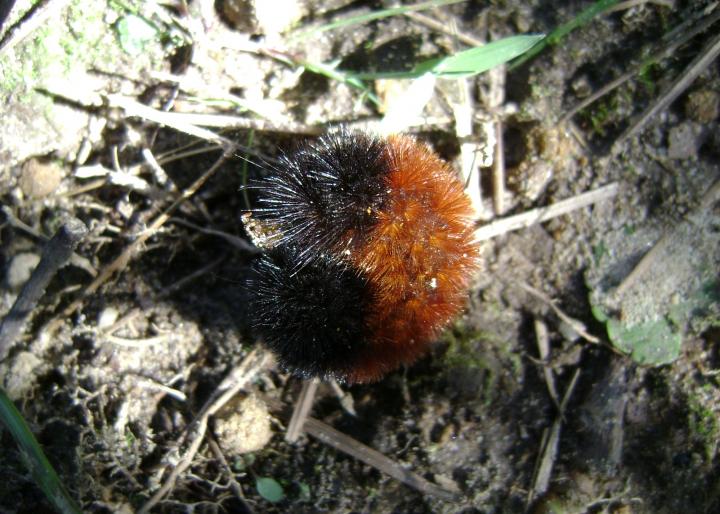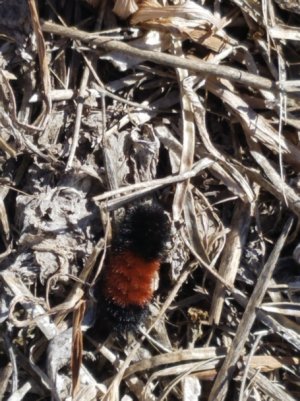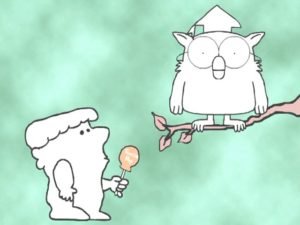Did anyone pay attention to the Wooly buggers this fall ? I only saw one and it was pitch black with no bands at all and here we are with a bunch of snow on the ground. It must be true. :;:stirthepot
You are using an out of date browser. It may not display this or other websites correctly.
You should upgrade or use an alternative browser.
You should upgrade or use an alternative browser.
Woolly Bear caterpillar
- Thread starter Davey Crockett
- Start date
Mostly Hogwash but I like legends
Here’s the legend: The Woolly Bear caterpillar has 13 distinct segments of either rusty brown or black. The wider the rusty brown sections (or the more brown segments there are), the milder the coming winter will be. The more black there is, the more severe the winter.
[h=3]HOW THE WOOLLY BEAR CATERPILLAR BECAME “FAMOUS”[/h]

Isabella Tiger Moth. Photo by Andy Reago & Chrissy McClarren/Wikimedia Commons.
[h=3]DO WOOLLY BEAR CATERPILLARS FORECAST WINTER WEATHER?[/h]Between 1948 and 1956, Dr. Curran’s average brown-segment counts ranged from 5.3 to 5.6 out of the 13-segment total, meaning that the brown band took up more than a good third of the woolly bear’s body. The corresponding winters were milder than average, and Dr. Curran concluded that the folklore has some merit and might be true.
But Curran was under no scientific illusion: He knew that his data samples were small. Although the experiments legitimized folklore to some, they were simply an excuse for having fun. Curran, his wife, and their group of friends escaped the city to see the foliage each fall, calling themselves The Original Society of the Friends of the Woolly Bear.
Thirty years after the last meeting of Curran’s society, the woolly bear brown-segment counts and winter forecasts were resurrected by the nature museum at Bear Mountain State Park. The annual counts have continued, more or less tongue in cheek, since then.
For the past 10 years, Banner Elk, North Carolina, has held an annual “Woolly Worm Festival” each October, highlighted by a caterpillar race. Retired mayor Charles Von Canon inspects the champion woolly bear and announces his winter forecast.
If the rusty band is wide, then it will be a mild winter. The more black there is, the more severe the winter.

Woolly bear caterpillar in its defensive posture.
Most scientists discount the folklore of woolly bear predictions as just that, folklore. Says Ferguson from his office in Washington, “I’ve never taken the notion very seriously. You’d have to look at an awful lot of caterpillars in one place over a great many years in order to say there’s something to it.”
Mike Peters, an entomologist at the University of Massachusetts, doesn’t disagree, but he says there could, in fact, be a link between winter severity and the brown band of a woolly bear caterpillar. “There’s evidence,” he says, “that the number of brown hairs has to do with the age of the caterpillar—in other words, how late it got going in the spring. The [band] does say something about a heavy winter or an early spring. The only thing is … it’s telling you about the previous year.”
Every year, the wooly worms do indeed look different—and it depends on their region. So, if you come across a local woolly worm, observe the colors of the bands and what they foretell about your winter weather.
What’s the real winter weather prediction for 2018? The 2019 Old Farmer’sAlmanac was just released! Look inside for our official forecast!
- - - Updated - - -
https://www.almanac.com/content/woolly-bear-caterpillars-and-weather-prediction
Here’s the legend: The Woolly Bear caterpillar has 13 distinct segments of either rusty brown or black. The wider the rusty brown sections (or the more brown segments there are), the milder the coming winter will be. The more black there is, the more severe the winter.
[h=3]HOW THE WOOLLY BEAR CATERPILLAR BECAME “FAMOUS”[/h]
- In the fall of 1948, Dr. C. H. Curran, curator of insects at the American Museum of Natural History in New York City, took his wife 40 miles north of the city to Bear Mountain State Park to look at woolly bear caterpillars.
- Dr. Curran collected as many caterpillars as he could in a day, determined the average number of reddish-brown segments, and forecast the coming winter weather through a reporter friend at The New York Herald Tribune.
- Dr. Curran’s experiment, which he continued over the next eight years, attempted to prove scientifically a weather rule of thumb that was as old as the hills around Bear Mountain. The resulting publicity made the woolly worm the most recognizable caterpillar in North America.
- This medium-size moth, with yellowish-orange and cream-colored wings spotted with black, is common from northern Mexico throughout the United States and across the southern third of Canada.
- As moths go, the Isabella isn’t much to look at compared with other species, but its immature larva, called the black-ended bear or the woolly bear (and, throughout the South, woolly worm) is one of the few caterpillars most people can identify.
- Woolly bears do not actually feel much like wool—they are covered with short, stiff bristles of hair.
- In field guides, they’re found among the “bristled” species, which include the all-yellow salt marsh caterpillar and several species in the tiger moth family. Not all are ‘woolly bears!’
- Woolly bears, like other caterpillars, hatch during warm weather from eggs laid by a female moth.
- Mature woolly bears search for overwintering sites under bark or inside cavities of rocks or logs. (That’s why you see so many of them crossing roads and sidewalks in the fall.)
- When spring arrives, woolly bears spin fuzzy cocoons and transform inside them into full-grown moths.
- Typically, the bands at the ends of the caterpillar are black, and the one in the middle is brown or orange, giving the woolly bear its distinctive striped appearance.

Isabella Tiger Moth. Photo by Andy Reago & Chrissy McClarren/Wikimedia Commons.
[h=3]DO WOOLLY BEAR CATERPILLARS FORECAST WINTER WEATHER?[/h]Between 1948 and 1956, Dr. Curran’s average brown-segment counts ranged from 5.3 to 5.6 out of the 13-segment total, meaning that the brown band took up more than a good third of the woolly bear’s body. The corresponding winters were milder than average, and Dr. Curran concluded that the folklore has some merit and might be true.
But Curran was under no scientific illusion: He knew that his data samples were small. Although the experiments legitimized folklore to some, they were simply an excuse for having fun. Curran, his wife, and their group of friends escaped the city to see the foliage each fall, calling themselves The Original Society of the Friends of the Woolly Bear.
Thirty years after the last meeting of Curran’s society, the woolly bear brown-segment counts and winter forecasts were resurrected by the nature museum at Bear Mountain State Park. The annual counts have continued, more or less tongue in cheek, since then.
For the past 10 years, Banner Elk, North Carolina, has held an annual “Woolly Worm Festival” each October, highlighted by a caterpillar race. Retired mayor Charles Von Canon inspects the champion woolly bear and announces his winter forecast.
If the rusty band is wide, then it will be a mild winter. The more black there is, the more severe the winter.

Woolly bear caterpillar in its defensive posture.
Most scientists discount the folklore of woolly bear predictions as just that, folklore. Says Ferguson from his office in Washington, “I’ve never taken the notion very seriously. You’d have to look at an awful lot of caterpillars in one place over a great many years in order to say there’s something to it.”
Mike Peters, an entomologist at the University of Massachusetts, doesn’t disagree, but he says there could, in fact, be a link between winter severity and the brown band of a woolly bear caterpillar. “There’s evidence,” he says, “that the number of brown hairs has to do with the age of the caterpillar—in other words, how late it got going in the spring. The [band] does say something about a heavy winter or an early spring. The only thing is … it’s telling you about the previous year.”
Every year, the wooly worms do indeed look different—and it depends on their region. So, if you come across a local woolly worm, observe the colors of the bands and what they foretell about your winter weather.
What’s the real winter weather prediction for 2018? The 2019 Old Farmer’sAlmanac was just released! Look inside for our official forecast!
- - - Updated - - -
https://www.almanac.com/content/woolly-bear-caterpillars-and-weather-prediction
I've seen some this year that the brown band is very dark, almost black but not quite. I've also seen quite a few that the brown band is quite brown. I don't know if this means anything or not but i do know if I see these wooly buggers heading south then we probably should to.
Nothing a little manscaping can't take care of.
Saw one in a stubble field last week, mostly orange so fingers crossed....
Seen a few with a nice wide brown band of color.
Same here.
How many acorns, How high above the ground bees build their nest , How far from shore muskrats build their houses and the size of their feeder house , If you have a few random ants and see a dike/mound around a ant hole it's going to rain. Cows laying down it's going to rain . Red sky in morning is a sailors warning red sky at night is a Sailors delight. How big the hillbillies wood pile is is. Haha. So many I can't recall them all. I was fortunate to grow up around old timers telling stories that the old timers used to tell. They talked about the barometer a lot too.
- - - Updated - - -
Before computerage age the Old Farmers Almanac was the big wealth of knowledge.
- - - Updated - - -
Before computerage age the Old Farmers Almanac was the big wealth of knowledge.
Interesting these old timer weather predicting folklores are fun to pay attention to and see how they turn out. Any other ones I can keep my eyes open for?
Buffalo berry trees and the amount of berries on them are supposed to be an indicator as well. Since they do not sweeten until after a frost they are a sustainable winter fruit for many animals. If the trees are bare or mostly bare, the winter should be easy with little snow. If the trees are loaded and more notably how high up the bush, the more snow and harsh cold we are to expect.
I have lived at my house for 5 years, this is the first year I have seen the buffalo berries this loaded and all the way to the top.
Side note, made some jam after the first couple hard freezes we had, pern near as a good as chokecherry jam!
- Joined
- Jul 16, 2015
- Posts
- 276
- Likes
- 3
- Points
- 125
Rain follows 30 days after a fog.
The butcher cow's spleen is the tell for winter, skinny equals a mild winter.
long and fat, not good.
Skinny with a fat section, means there will be at big weather event in a reletivley mild winter.
Buffalo Berries and chokecherries are thicker than Ive seen in 15 years or so.
May be a good idea to tune up the snowblower.
The butcher cow's spleen is the tell for winter, skinny equals a mild winter.
long and fat, not good.
Skinny with a fat section, means there will be at big weather event in a reletivley mild winter.
Buffalo Berries and chokecherries are thicker than Ive seen in 15 years or so.
May be a good idea to tune up the snowblower.
[h=3]Woolly Bear Folklore:[/h]According to folklore, the amount of black on the woolly bear in autumn varies proportionately with the severity of the coming winter in the locality where the caterpillar is found. The longer the woolly bear's black bands, the longer, colder, snowier, and more severe the winter will be. Similarly, the wider the middle brown band is associated with a milder upcoming winter. The position of the longest dark bands supposedly indicates which part of winter will be coldest or hardest. If the head end of the caterpillar is dark, the beginning of winter will be severe. If the tail end is dark, the end of winter will be cold. In addition, the woolly bear caterpillar has 13 segments to its body, which traditional forecasters say correspond to the 13 weeks of winter.
As with most folklore, there are 2 other versions to this story. The first one says that the woolly bear caterpillar's coat will indicate the upcoming winter's severity. So, if its coat is very woolly, it will be a cold winter. The final version deals with the woolly bear caterpillar's direction of travel of the worms. It is said that woolly bear's crawling in a southerly direction are trying to escape the cold winter conditions of the north. On the other hand, woolly bear's crawling on a northward path would indicate a mild winter.
Looks like a good amount of brown on it although it was pretty wooly and was crawling south east. The top of the picture is the head end or the way it was crawling. So according to this maybe not a lot of snow but a cold winter, with the start of winter have a long cold streak. Will be fun/interesting to keep track of this. See you in spring��
I thought I'd posted last fall but can't find it. According to the Woolley I saw last fall, this warm front is on schedule and supposed to be a mild winter till the end then go out like a lion . Time will tell.
Similar threads
Recent Posts
-
Prairie ghost
- Latest: grumster
-
EV mountain bikes
- Latest: snow2
-
Riddle Me This.....
- Latest: CatDaddy
-
Mercer county deputy killed
- Latest: svnmag
-
Sale Ruger Red Label 20 ga
- Latest: tikkalover
-
More CWD NE ND
- Latest: guywhofishes
-
"Conspiracy Theory" or not?
- Latest: Wally World
-
Once in a Lifetime E2 Elk Cow
- Latest: wslayer
-
Outdoor Playsets
- Latest: tikkalover
-
Custom Wood Carver?
- Latest: Pheasant 54
-
I'm in the market
- Latest: grumster
-
Israel
- Latest: lunkerslayer
-
Weather...
- Latest: lunkerslayer
-
Tail Gate Tent
- Latest: wslayer
-
Sale Yamaha Saltwater 2 prop. $400
- Latest: bowhunter12
-
Sale Leopold BX4 Range,10x42. $1250
- Latest: bowhunter12
-
What are you listening to these days?
- Latest: SDMF
-
1969 Evinrude 25 sportster
- Latest: rodcontrol
-
Baltimore bridge collapse
- Latest: Allen
-
Rain
- Latest: Davey Crockett
Friends of NDA
Top Posters of the Month
-
This month: 107
-
- Posts
- 885
-
- Likes
- 840
-
-
This month: 96
-
- Posts
- 1,994
-
- Likes
- 830
-
-
This month: 70
-
- Posts
- 503
-
- Likes
- 186
-
-
This month: 66
-
- Posts
- 1,380
-
- Likes
- 868
-


